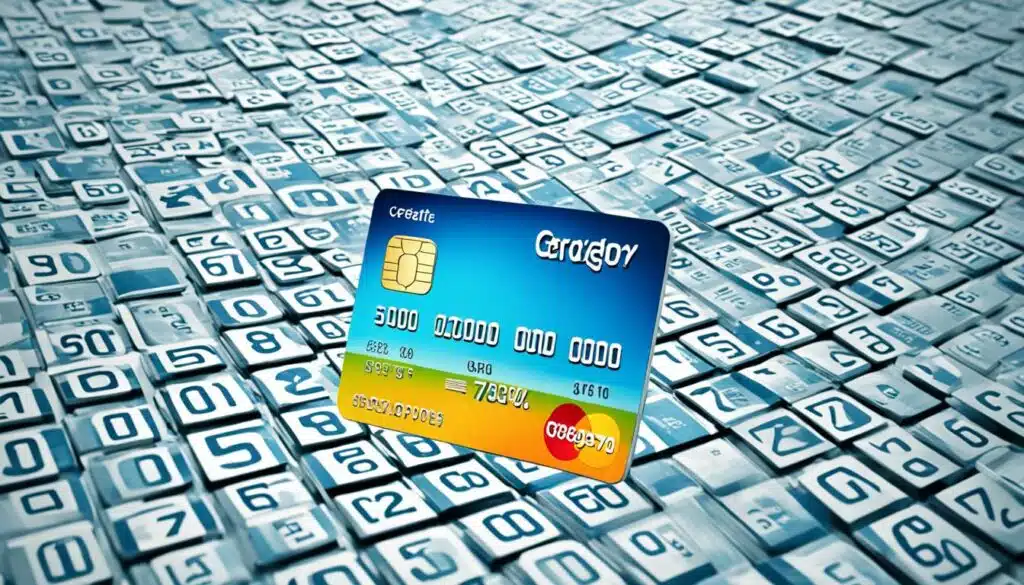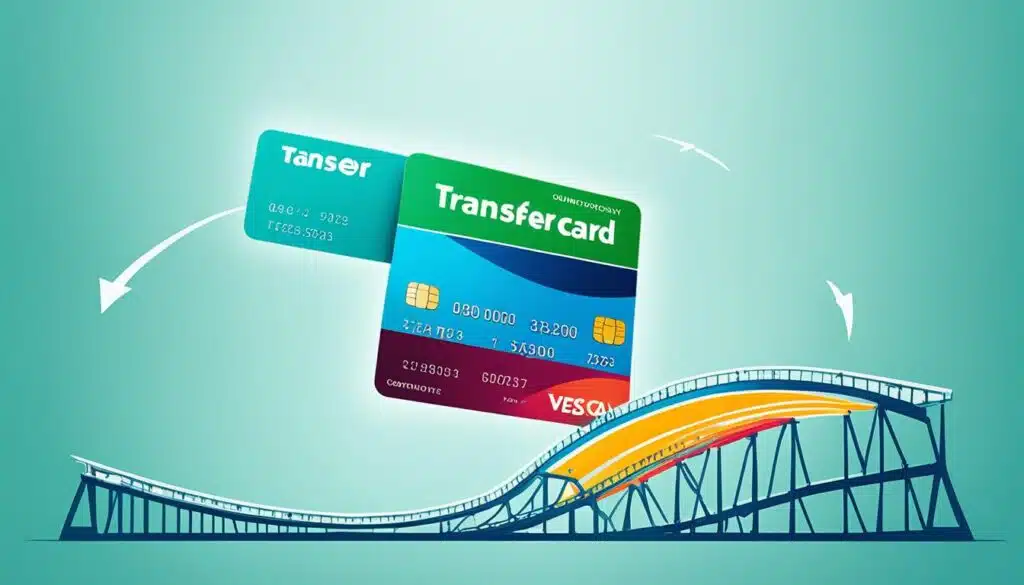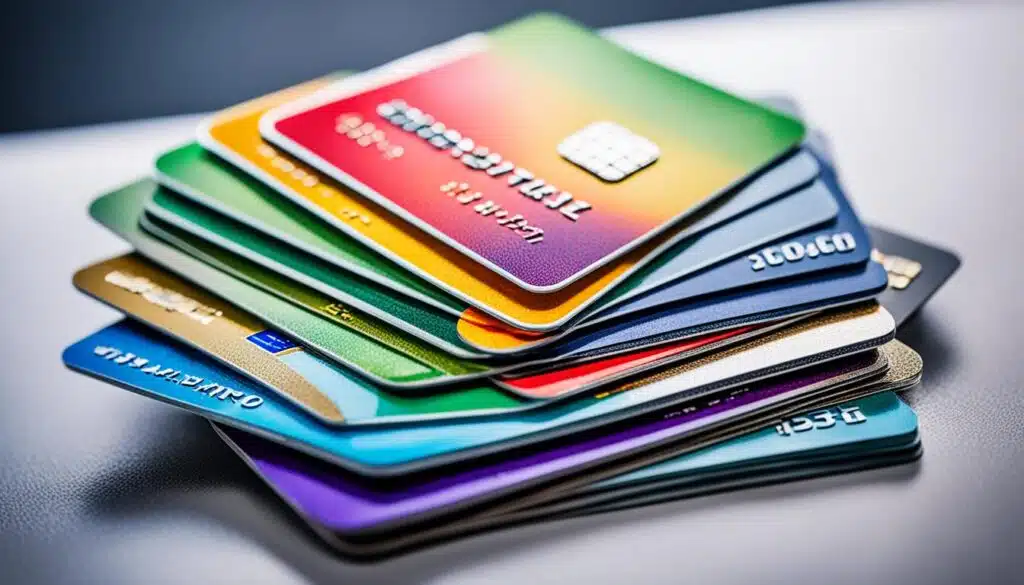Money transfer credit cards are versatile financial tools that can help with clearing overdrafts, providing cheap loans, and transferring balances. However, for saving on existing credit card debt or making direct purchases, other types of cards may be more suitable. It is important to compare the total costs and benefits before choosing the best money transfer credit card for your needs in 2024.
Key Takeaways: Money Transfer Credit Cards
- Money transfer credit cards are beneficial for clearing overdrafts and providing cheap loans.
- When compared to money transfer credit cards, balance transfer credit cards offer better deals for saving on existing credit card debt.
- A 0% purchase card is more suitable for direct purchases that can be paid for using a credit card.
- For borrowing larger amounts, traditional loans may offer better interest rates and repayment terms than money transfer credit cards.
- Maximizing credit card benefits requires responsible credit card management, including making minimum repayments and avoiding unnecessary spending.
Clearing an Overdraft with a Money Transfer Credit Card
Money transfer credit cards can be a valuable tool for individuals looking to clear an overdraft. Banks often charge high interest rates on overdrafts, which can quickly accumulate and become burdensome for individuals. By utilizing a money transfer credit card, individuals can take advantage of 0% interest offers and save a significant amount of money.
Transferring the overdraft amount to a money transfer credit card with 0% interest allows individuals to manage their funds more efficiently and reduce their debt. With no interest charges accruing, individuals can focus on paying off the balance without worrying about increasing debt due to interest fees.
Clearing an overdraft with a money transfer credit card offers several advantages. First, it provides a cost-effective solution as individuals can save on the high interest rates typically associated with overdrafts. Secondly, it allows for greater control over personal finances by consolidating the overdraft into a single credit card balance, eliminating the need to manage multiple debt obligations. Lastly, it provides a clear repayment plan with a fixed timeline, enabling individuals to work towards becoming debt-free.
How it works:
- Apply for a money transfer credit card with 0% interest on balance transfers.
- If approved, transfer the overdraft amount to the new credit card.
- Set up a repayment plan to pay off the balance over an agreed-upon period.
- Make regular payments to reduce the balance until it is completely cleared.
Clearing an overdraft with a money transfer credit card can provide individuals with the opportunity to save on interest charges and efficiently manage their finances. By taking advantage of 0% interest offers, individuals can focus on reducing their debt and ultimately become more financially stable.
Also Read : Smart Shopping At Money Saving Supermarket
Using a Money Transfer Credit Card for Cheap Loans
Money transfer credit cards offer a convenient and cost-effective solution for individuals looking to borrow smaller amounts, such as up to £5,000. With their lower interest rates and flexible repayment options, these cards can be an excellent choice for those in need of a cheap loan.
One of the key benefits of using a money transfer credit card for borrowing is the ability to use the funds to pay friends, tradespeople, or anyone else who does not accept credit cards. This feature allows individuals to conveniently manage their debts without the need for cash or other payment methods.
When compared to traditional borrowing methods, such as personal loans, money transfer credit cards often come out as a more cost-effective option. They can offer lower interest rates and fees, making them an attractive choice for those seeking affordable financing.
Moreover, money transfer credit cards provide flexibility in terms of repayment. Cardholders can choose from various repayment options, allowing them to customize their loan repayment according to their financial situation and monthly budget.
Benefits of Using a Money Transfer Credit Card for Cheap Loans:
- Lower interest rates compared to other borrowing options
- Flexibility in repayment options
- Ability to pay friends, tradespeople, or others who don’t accept credit cards
- Convenient and secure payment method
- No need for cash or alternative payment methods
By taking advantage of these benefits, individuals can effectively manage their borrowing needs through money transfer credit cards, ensuring a cost-effective and convenient loan solution.
Saving on Existing Credit Card Debt with Balance Transfer Credit Cards

When it comes to saving on existing credit card debt, balance transfer credit cards can provide a better deal compared to money transfer credit cards. These cards often offer lower fees and longer interest-free periods, allowing individuals to clear their debts more efficiently.
By transferring the balance from their current credit cards to a balance transfer credit card, individuals can take advantage of reduced costs and potentially save a significant amount of money. This can be particularly beneficial for those carrying a high balance and struggling with high-interest rates.
One of the main advantages of balance transfer credit cards is their lower fees. Compared to money transfer credit cards, which may come with higher fees due to the cash transfer aspect, balance transfer cards tend to have lower or no transfer fees. This can result in immediate savings for individuals looking to reduce their credit card debt.
In addition to lower fees, balance transfer credit cards often provide longer interest-free periods. This means that individuals have more time to pay off their existing debt without incurring any interest charges. By taking advantage of this interest-free period, individuals can make significant progress in reducing their overall debt.
The Benefits of Balance Transfer Credit Cards for Existing Credit Card Debt:
- Lower fees: Balance transfer credit cards often come with lower or no transfer fees, allowing individuals to save money when consolidating their credit card debt.
- Longer interest-free periods: Balance transfer credit cards provide individuals with more time to pay off their debt without incurring any interest charges, making it easier to manage their finances and reduce their overall debt.
- Reduced monthly payments: By consolidating multiple credit card balances onto one balance transfer credit card, individuals can simplify their finances and potentially lower their monthly payments.
- Opportunity to improve credit score: Responsible management of a balance transfer credit card, such as making timely payments and reducing debt, can help improve an individual’s credit score over time.
However, it is important to note that balance transfer credit cards may not be suitable for everyone. The specific terms and conditions of each card should be carefully considered to ensure that the savings and benefits outweigh any potential drawbacks.
Individuals considering a balance transfer credit card should compare different options and evaluate factors such as the length of the interest-free period, any transfer fees, and the regular APR (Annual Percentage Rate) after the interest-free period expires. By carefully analyzing these factors, individuals can find the balance transfer credit card that offers the best deal for their existing credit card debt.
Overall, balance transfer credit cards present a valuable opportunity for individuals looking to save on existing credit card debt. With lower fees, longer interest-free periods, and potential monthly payment reductions, these cards can provide a practical and cost-effective solution for managing debt and achieving financial stability.
Also Read :Crossing Currencies: Navigating The Global Money Exchange
Using a 0% Purchase Card for Direct Purchases

When it comes to making direct purchases that can be paid for using a credit card, a 0% purchase card can offer a more cost-effective solution compared to a money transfer credit card. With lower interest rates for a set period of time, these cards provide individuals with the flexibility to manage their credit card expenses efficiently. However, it is crucial to carefully review the terms and conditions of the 0% purchase card before proceeding with any direct purchases.
By opting for a 0% purchase card, individuals can take advantage of the interest-free period to pay off their purchases without accumulating high interest charges. This can be particularly beneficial when making larger purchases or for individuals who prefer to spread their payments over time.
In addition to the interest savings, using a 0% purchase card for direct purchases allows individuals to conveniently track their credit card expenses. Monthly statements provide a clear overview of the amount spent and any remaining balance, making it easier to manage and budget finances.
Benefits of a 0% Purchase Card:
- Lower interest rates during the promotional 0% period
- Flexibility to spread payments over time
- Convenient tracking and management of credit card expenses
- Opportunity to earn rewards or cashback on eligible purchases
Using a 0% purchase card is a smart way to effectively manage credit card expenses while taking advantage of lower interest rates. However, it is important to understand that once the 0% promotional period ends, standard interest rates will apply, so it’s crucial to have a repayment plan in place to avoid any unnecessary charges.
Before applying for a 0% purchase card, it’s essential to consider personal financial circumstances and spending habits. Some cards may have annual fees or require a minimum income threshold, so it’s important to evaluate various options and choose the one that best suits individual needs.
Remember, while a 0% purchase card can be a valuable financial tool for managing direct purchases, it’s important to use credit cards responsibly and avoid overspending beyond one’s means. With careful planning and responsible usage, a 0% purchase card can contribute to sound financial management and help individuals meet their purchasing needs.
Also Read : How To Invest Money Uk?
Borrowing More than £5,000 – Traditional Loans vs Money Transfer Credit Cards

When it comes to borrowing more than £5,000, individuals have two main options to consider: traditional loans and money transfer credit cards. Both options have their own advantages and it’s important to carefully compare the total costs and benefits before making a decision.
Traditional loans, offered by banks and financial institutions, can often provide better interest rates and repayment terms for larger amounts. These loans are typically repaid over a fixed period of time, allowing borrowers to plan their finances accordingly. Additionally, traditional loans may offer more flexible borrowing options, such as secured or unsecured loans, depending on the individual’s circumstances.
On the other hand, money transfer credit cards are more suitable for smaller loans. These credit cards allow users to transfer funds from the card to their bank account, providing a convenient and quick borrowing option. While money transfer credit cards may carry higher interest rates compared to traditional loans, they often come with promotional offers such as 0% interest for an introductory period. This can be advantageous for individuals who have a short-term borrowing need and can repay the amount within the interest-free period.
| Traditional Loans | Money Transfer Credit Cards |
|---|---|
| Lower interest rates for larger amounts | Convenient and quick borrowing for smaller amounts |
| Fixed repayment terms | Offer promotional offers such as 0% interest for an introductory period |
| Flexible borrowing options (secured/unsecured) | Ability to transfer funds from the card to a bank account |
When comparing the total costs, it’s important to consider all associated fees and charges, including any balance transfer fees, annual fees, and late payment fees. Additionally, individuals should assess their own financial situation, repayment capacity, and borrowing needs to determine which option is the most suitable for their specific circumstances.
Overall, for larger borrowing needs, traditional loans often offer better interest rates and more flexible borrowing options. On the other hand, money transfer credit cards can be a convenient and cost-effective solution for smaller loans, especially for individuals who can take advantage of the promotional offers and repay the borrowed amount within the interest-free period.
Make an Informed Decision
When considering borrowing more than £5,000, it’s crucial to carefully evaluate both traditional loans and money transfer credit cards. By comparing the total costs, interest rates, repayment terms, and individual borrowing needs, individuals can make an informed decision that aligns with their financial goals and circumstances.
Also Read : How do Stock Trading Platforms Impact Market Accessibility?
Best Balance Transfer Credit Cards for 2024

In 2024, several balance transfer credit cards are offering attractive deals for individuals who want to transfer their existing debts. These cards provide an opportunity to consolidate multiple debts into a single payment and potentially save on interest charges. The best balance transfer credit cards are determined by two key factors: the length of the interest-free period and the balance transfer fee. Longer interest-free periods provide more time to pay off the debt without accruing interest. However, it’s important to consider personal financial circumstances and repayment capabilities when choosing the best balance transfer credit cards for 2024.
To help you make an informed decision, here are some of the top balance transfer credit cards available in 2024:
1. XYZ Bank Balance Transfer Card
“With an interest-free period of 18 months and a low balance transfer fee of just £25, the XYZ Bank Balance Transfer Card offers a great deal for individuals looking to save on their debt.”
2. ABC Credit Union Platinum Card
“The ABC Credit Union Platinum Card provides a generous interest-free period of 24 months, giving borrowers more time to pay off their balances. Plus, there is no balance transfer fee, making it an attractive option for those looking to eliminate credit card debt.”
These are just a few examples of the best balance transfer credit cards available in 2024. It’s important to compare the details of each card, including the interest-free period, balance transfer fee, and any additional benefits or rewards offered. By carefully considering your own financial situation and goals, you can choose the balance transfer credit card that offers the best deal for you.
Also Read :How Can Beginners Start Their Journey Into Stock Trading?
Getting the Most Out of a Credit Card
When it comes to credit cards, responsible management is key to maximizing the benefits they offer. By adopting smart financial habits, individuals can make the most out of their credit cards while avoiding unnecessary costs. Here are some tips to help you optimize your credit card usage:
1. Make Minimum Repayments on Time
One of the most important aspects of responsible credit card management is making at least the minimum repayments on time. By doing so, you avoid incurring late payment fees and damaging your credit score. Additionally, timely repayments ensure that you maintain access to interest-free periods and other card benefits.
2. Avoid Unnecessary Spending
While credit cards provide convenience and flexibility, it’s important to avoid unnecessary spending that can lead to debt accumulation. Before making a purchase, ask yourself if it’s a necessity or if it can be deferred. By being mindful of your spending habits, you can prevent excessive debt and maintain control over your finances.
3. Set Reminders for Interest-Free Periods
If you’re taking advantage of an interest-free period offered by your credit card, it’s crucial to set reminders for its expiration. Interest charges can be substantial when the promotional period ends. By being proactive and planning your repayments accordingly, you can avoid unexpected costs and continue enjoying interest-free benefits.
4. Consider Balance Transfers
When you have an outstanding balance on one credit card, considering a balance transfer to another card can be a strategic move. By transferring the balance to a card with a lower interest rate or a longer interest-free period, you can save on interest charges and accelerate your repayment efforts.
Remember, it’s important to assess the balance transfer fees and other charges associated with the new card to ensure that the potential savings outweigh the costs.
5. Maximize Credit Card Benefits
Credit cards often come with a range of benefits, such as cashback rewards, travel insurance, or purchase protection. To make the most out of your card, familiarize yourself with the offered perks and actively utilize them. Whether it’s earning cashback on everyday expenses or taking advantage of discounts on travel bookings, maximizing these benefits can help you save money and enhance your overall credit card experience.
By practicing responsible credit card management, including making minimum repayments on time, being mindful of your spending, setting reminders for interest-free periods, considering balance transfers, and maximizing credit card benefits, you can harness the full potential of your credit cards while maintaining financial stability.
Qualifying for a Credit Card and Improving Credit Rating

Qualifying for a credit card with the best deals requires a good credit score. To achieve this, it is crucial to maintain a positive credit history, pay bills on time, and register on the electoral roll. Improving your credit rating is essential for accessing the most favorable credit card offers and increasing the chances of approval.
Building a solid credit history is a key step in qualifying for a credit card. Lenders assess your creditworthiness based on your past financial behavior, including how responsibly you have managed credit in the past. Maintaining low credit card balances, making regular payments, and avoiding late payments can all contribute to a positive credit history.
Another factor that lenders consider is your payment history for your previous loans, mortgages, and bills. Paying these on time demonstrates your financial responsibility and can help improve your credit rating. If you have any outstanding debts, prioritizing their repayment can have a positive impact on your credit score.
Being registered on the electoral roll is another way to improve your credit rating. This helps lenders verify your identity and address, giving them confidence in your stability and reducing the risk associated with lending to you. Registering on the electoral roll is usually a straightforward process and can be done online or by mail.
“A good credit score opens the door to a wide array of credit card options and better terms. By qualifying for a credit card, individuals can enjoy the benefits they offer, such as cashback, rewards, and introductory 0% APR offers.”
Improving your credit rating takes time, patience, and responsible financial management. However, the effort is worth it as it can significantly improve your chances of qualifying for a credit card with favorable terms and conditions.
To summarize, to qualify for the best credit card deals, it is essential to focus on improving your credit rating. Maintaining a positive credit history, paying bills on time, and registering on the electoral roll are critical steps to boost your creditworthiness. By taking these measures, you increase your chances of approval and gain access to a wider range of credit card options.
Also Read: Explore The Best Money Platform Solutions
Conclusion
Money transfer credit cards are an effective tool for managing finances and addressing various financial needs. Whether you need to clear overdrafts, obtain cheap loans, or save on existing credit card debt, these cards offer cost-effective solutions.
However, it is crucial to consider different options and evaluate personal financial circumstances to find the best money transfer credit card for 2024. Each individual’s needs may vary, and comparing the features, interest rates, and fees of different cards can help identify the most suitable option.
By taking the time to research and compare, individuals can select the money transfer credit card that best fits their financial goals and provides the most benefits. Whether it’s clearing debt, accessing affordable loans, or maximizing savings, making an informed choice ensures the best possible outcome.
FAQs
Q: How do money transfer credit cards work?
A: Money transfer credit cards work by allowing you to transfer funds from your credit card to your bank account. This can be useful for consolidating debt or accessing cash quickly.
Q: What is a money transfer card?
A: A money transfer card is a type of credit card that allows you to transfer money from the card to your bank account, usually for a fee or a promotional interest rate.
Q: How can I get a money transfer credit card?
A: To get a money transfer credit card, you typically need to have a good credit score and apply with a credit card provider that offers this type of card.
Q: What are the benefits of using a money transfer credit card?
A: One benefit of using a money transfer credit card is the ability to access funds quickly or consolidate debt. Additionally, some cards offer promotional interest rates for a set period.
Q: What are transfer fees associated with money transfer credit cards?
A: Transfer fees are charges incurred when transferring money from a credit card to a bank account. These fees vary among card providers and should be considered before initiating a transfer.
Q: How can I find the best money transfer credit card for my needs?
A: To find the best money transfer credit card, compare different card providers, consider the transfer fees, promotional interest rates, and benefits offered by each card.
Q: Can I transfer money from a credit card to my current account?
A: Yes, you can transfer money from a credit card to your current account using a money transfer credit card. However, be mindful of any fees and interest charges that may apply.
Source Links
- https://www.money.co.uk/credit-cards/0-money-transfer-credit-cards
- https://www.thetimes.co.uk/money-mentor/loans-credit-cards/credit-cards/best-balance-transfer-credit-cards
- https://www.which.co.uk/money/credit-cards-and-loans/credit-cards/best-credit-card-deals/best-0-balance-transfer-credit-cards-atMFj4R64A0D









